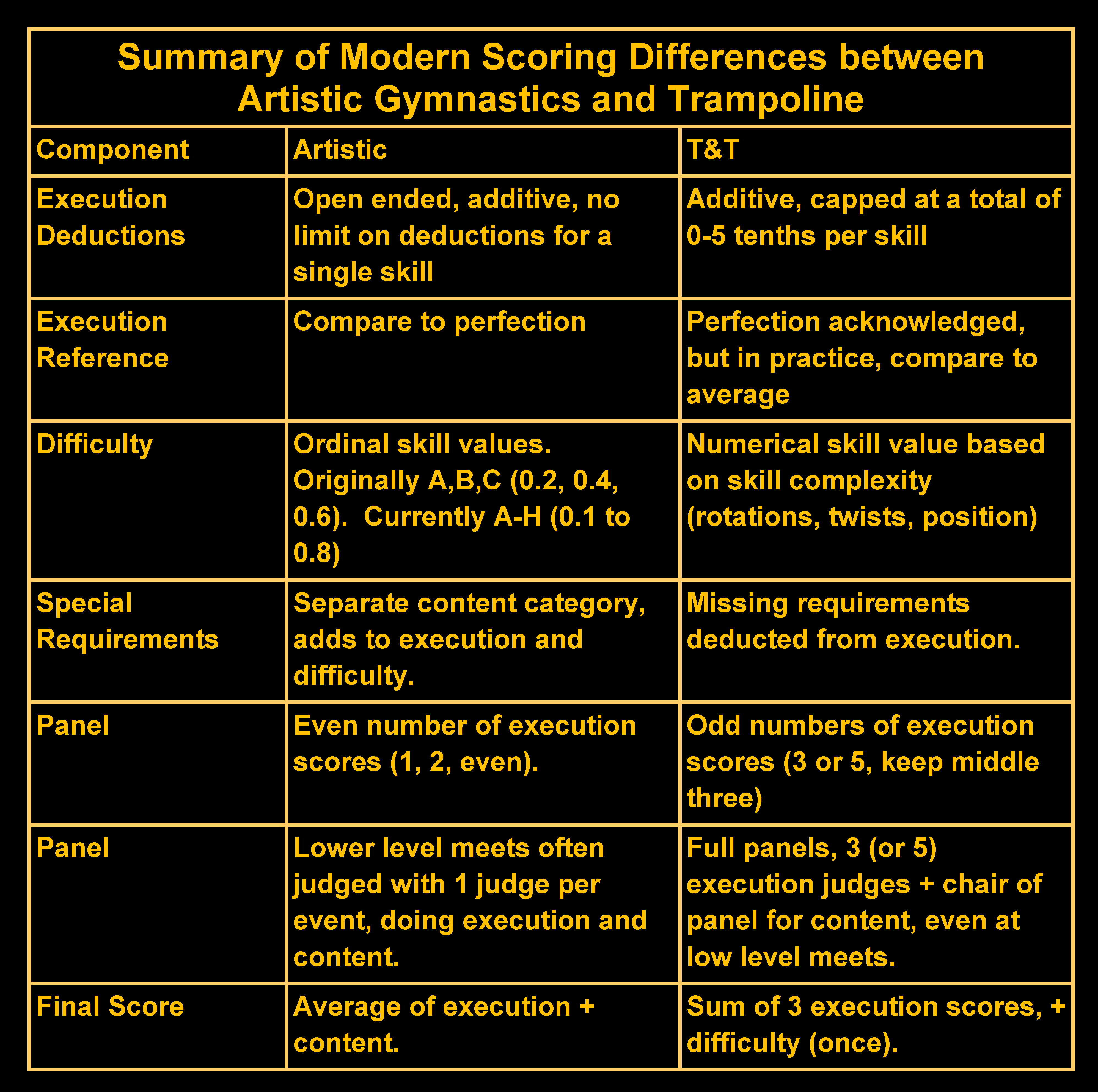<Previous History Item Next History Item>
This is an introduction for two different stories, one about the governing of trampoline as a competitive sport, and another about how the scoring system for trampoline developed. The two stories run in parallel, and are intertwined with each other. The best place to begin is with a snapshot of how things look today. Currently, Trampoline and Tumbling is governed internationally by the International Gymnastics Federation (FIG), and the official domestic governing body is USA Gymnastics (USAG). There is a second smaller domestic governing body called the US Trampoline and Tumbling Association (USTA). USTA runs its own meets and has its own national championship, but is not the path to international competition.
Trampoline competition is currently evaluated by a mature set of scoring rules that look very different from those of “Artistic Gymnastics” (the events you have seen in the Olympics since the 1960s). The two worlds (Artistic versus T&T) have completely different views on how to score execution, and have different ways of putting a judging panel together and assembling the final score. However, the biggest difference is in how the two worlds evaluate difficulty, with artistic gymnastics using a simple ordinal difficulty system (A,B,C…) with point values attached to each level, while trampoline uses a numerical difficulty system based on skill complexity (twist, rotation, position).
For those walking in now, it is easy to think that it has always been this way. To me it is a little surprising, because if you go back far enough, to the 1950s and 1960s, competitive trampoline and artistic gymnastics have a common origin. Trampoline is an American invention. In the 1950s, 60s, and even into the 70s, it shared a common venue with college and high-school gymnastics, and was judged by the same judges who scored the artistic events. I would propose that it is only due to a couple of accidents of history that the competitive format and scoring systems look as different as they do. Those accidents of history also impacted, and even created, the organizations that governed trampoline between 1960 and 2000. In order to understand this, we need to go back and get a picture of gymnastics in “The Time Before”.
The Time Before
Trampoline was woven into the tapestry of American Gymnastics in the late 1940s. At that time, the sport of gymnastics was still something of a free-for-all, with many more events than we see today. There were events in common across Europe and North America, and many that were only done in North America. Within the US, gymnastics was a patchwork, with an inconsistent array of events from region to region. Examining gymnastics publications of the day, you would probably tally more than a dozen events. Surviving events include the Pommel Horse, Parallel Bars, and Horizontal Bar for men, Uneven Parallel Bars and Balance Beam for women, with Vault and Free Exercise in common. Free exercise in a 40’x40’ square was a separate event from strip tumbling. (Free exercise was done on a bare floor with tape marking the edges. Athletes would often pad their clothing to perform skills like dive rolls.) Still Rings (low, all strength) was a separate event from “Flying Rings”, which was something in between rings and trapeze. There was a timed Rope Climb event, and Indian Clubs (something in between juggling and Rhythmic Gymnastics). There were even events shared with track & field such as high jump. Finally, there was trampoline, added to NCAA and AAU competition in 1947. The FIG had a smaller free-for-all, with a subset of these events, but a free-for-all nonetheless.
Scoring in the time before was simple. You could compete in a tournament-style elimination, with a judge (or time or height) picking the better of two in each bracket, or you could be scored for points and the point totals would determine the winner. The score was out of 10.0 points and was strictly execution. The method for making deductions was termed “Relative Scoring”. All deductions were made relative to the first athlete scored. Difficulty was considered, but only as part of a process called mitigation (now a dirty word in judging circles). Mitigation implied that you, as a judge, would be more lenient about deductions for form, etc., for skills of higher difficulty. Difficulty values were considered on paper. If you look back at older rulebooks (1950s AAU), you do see difficulty listed as A, B, or C level skills. However, they did not award points for difficulty, and nothing was added to the score; it was just a way of talking about difficulty. Judging panels were 3 or 5, with three scores counting, and the final score was a sum, not an average. The system was flexible enough to extend easily to all events. The FIG might write rules in Europe to cover the international events they governed, and it took little effort for the AAU to extend those rules to the US-only events.
The Middle of the Story
At this point, we have a picture of trampoline and gymnastics both now and in the time before, and the current scoring systems for Artistic Gymnastics and Trampoline both contain bits & pieces of the original system. It is time to look at the middle, to see how we got from one place to the other. The 1950s and 1960s were a time of upheaval for the gymnastics world, with a lot of wrestling for control of the sport, a lot of innovation, and the invention of the modern scoring systems for trampoline and artistic gymnastics at virtually the same moment.
<Previous History Item Next History Item>

